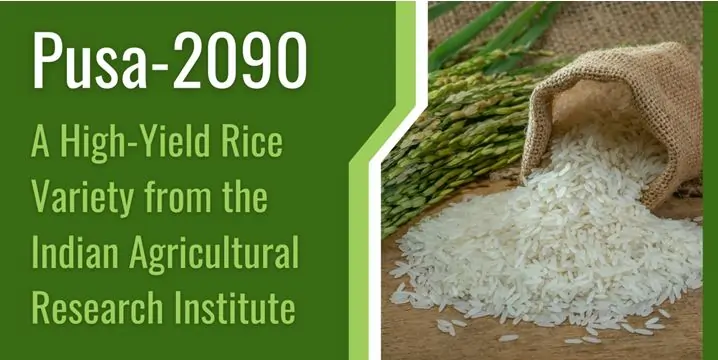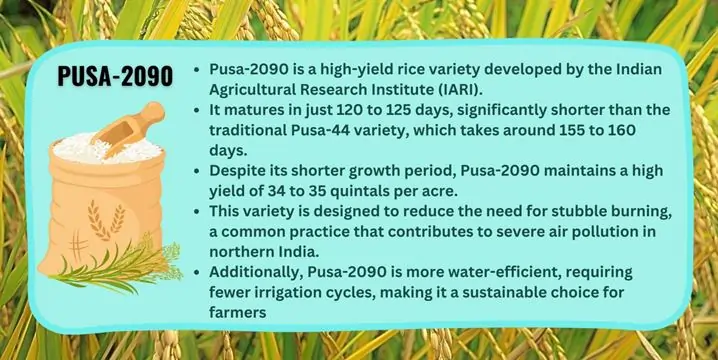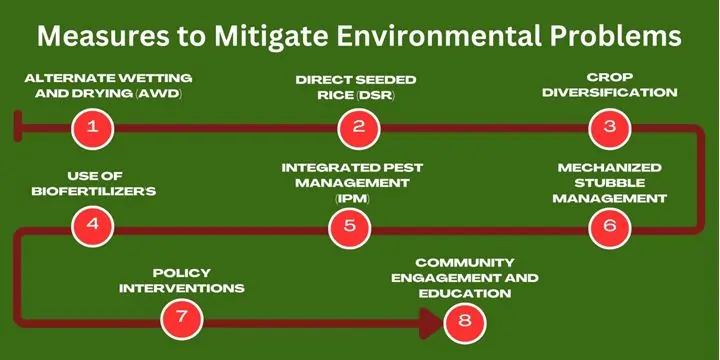
Indian Agricultural Research Institute (IARI) has been producing and disseminating agricultural innovations in India for a very long time. Their latest innovation, however, is Pusa- 2090, a high yielding, short duration rice variety that changed the face of rice cultivation in north states of India; especially where stubble burning is a major impediment.
The Genesis of Pusa-2090
Pusa-2090 is the outcome of the research and selection programme formulated and implemented by IARI scientists. It is a hybrid between the Pusa-44 new variety mostly cultivated at present and the early-maturing Japonica rice line, namely CB-501. In an effort to breed for a short duration with high yield, equal to Pusa-44, some of the major problems farmer come across were somewhat aimed by this variety.
Advantages of Pusa-2090: A High-Yield Rice Variety
- Shorter Maturation Period: Pusa-2090 has early maturity in 120 to 125 days against Pusa-44 and other traditional varieties take minimum 154 to 160 days. This shorter duration for growth enables farmers harvest rice early enough to allow them prepare for the next crop usually wheat without having to undertake environmentally unfriendly activities such as stubble burning.
- High Yield: Pusa-2090 has a relatively short time to mature but on the other side does not lower its yield. It remits an average yield of 34 to 35 quintals per acre, similar to that achieved from the long-duration varieties. This way the farmers can be able to meet their productivity levels and at the same time enjoy the benefits of the short growth cycle of the new crops.
- Environmental Benefits: Another major potential of Pusa-2090 is it could help in bringing down air pollution. As it increases the period farmers can devote to the preparation of their fields for the next crop, this means that a lot of stubbles will not be burnt, which is the major cause of rising air pollution in the northern part of the country. This makes Pusa-2090 an environment friendly method of rice production.

- Water Efficiency: Pusa-2090 is found to be more water efficient than the previous models of rice. This is easier to implement and leads to many fewer irrigation cycles, which equals real water savings for farmers. This is especially important in parts of the world where water shortage is becoming a real issue. This is because Pusa-2090 helps them practice water conservation hence supporting sustainable farming.
- Economic Benefits: On account of higher yield and short maturation period of Pusa 2090, farmers can gain more profit. The fact of the possibility of harvesting rice earlier contributes to an earlier planting of the other crops, which can contribute to a better crop management and, therefore, to the growth of productivity in general. This can lead to greater revenue for farmers and thus enhance of the welfare of farmers in the society.
- Adaptability: Pusa-2090 adapts to a number of agro-climatic conditions and would be beneficial for farmers in a variety of jurisdictions. This makes certain that the variety can be grown in a wide variety of circumstances and for this reason, rice growers confront with different climate adversities can rely on it.
- Reduced Labour Costs: The shorter growth cycle of Pusa-2090 has the impacts of lowering the labour cost implication for the farmer. When the planting and harvesting period is shorter, farmers are better placed to manage the available labour for this kind of farming. This leads to reduction on expenses and general farm management can be enhanced.
- Enhanced Food Security: Increased rice production and stable rice supply can advance the objective of food security and therefore; Pusa-2090 can support it. High yield and chief utilization of the available resources makes it possible not to have shortages of the essential product i.e. rice to cater for the demands of the people.
- Support for Sustainable Agriculture: Pusa-2090 has incorporated practices that are environmentally sustainable and resource friendly. The development and adoption of the technology demonstrate an ability to provide higher yield and sustainable food solutions to farmers and environment.
Adoption and Impact
The adoption of Pusa- 2090 is still limited but the few cases that have embraced the use of Pusa- 2090 are an indication that the facilitation of rootstock propagation is bound to increase. Those farmers that have ventured into using this variety have noted positive results. For example, Shukhjeet Singh Bhangu, a farmer from Sangrur district of Punjab revealed that Pusa-2090 helped him gain 30 more days to till his fields for the next crop. (As mentioned in the Times of India)
The IARI has also been pushing for Pusa-2090 to farmers who are more likely to double its usage in the next couple of years. The variety has already been officially released for the farmers in Delhi and experience of the latter indicates more farmers in Punjab and Haryana would shift to Pusa-2090.
Future perspective
However, Pusa-2090 has potential for broad use, yet there are several obstacles on its way. Farmers’ steps away from growing new varieties because of risks those are associated with them. Besides, the easy access of seeds, the appropriate training on the new developed variety is other important issues that need be considered.But with an increased support from the agricultural institutions and the government, all these are challenges that can be dealt with. The opportunity cost of using Pusa-2090 is low because the variety offers the farmer many benefits in terms of productivity and reduced environmental degradation.
Conclusion
Pusa-2090 is predefined successful lines for operation advancement in rice creation resultant in a high yield, short-duration modern rice variety. Because it helps in minimize stubble burning and water conservation for farmers, it has been considered as an environmentally friendly technology. This variety of rice when adopted by many farmers holds the potential to revolutionize rice production in India in terms both of production yield and environmental impact.
Environmental Concerns of Rice Production in India
Rice is one of the principal crops of India’s agriculture; it feeds millions and provides livelihood. However, it also presents many environmental problems that have to be solved to encourage sustainable farming operations. Some of the major environmental issues connected with rice production in India are outlined below;
- Greenhouse Gas Emissions: The high source of methane, a potent greenhouse gas emanates from rice paddies. Due to anaerobic conditions in the flooded rice fields, methanogen bacteria become active and the by-product formed here is methane. This greatly enhances warming of the environment since rice farming for instance contributes about 10 per cent of global methane emissions.
- Water Usage: Traditional methods require large volumes of water. This is a major cause for ground water depletionwhich is a rising concern for the future as it may cause water scarcity.
- Soil Degradation: This implies that compact continuous rice cultivation may cause deterioration of the soil. Puddling of the field which is done in many practices like plowing reduces the permeability and aeration of the soil. This in the long-run decreases the fertility of the soil.
- Stubble Burning: Farmers follow harvesting rice by using fire to clear the fields as fast as possible for the next crop after a specific crop is harvested. It discharges a substantial quantity of particulate matter and greenhouse gases thereby escalating a very bad air quality particularly in the northern region of India.
- Chemical Use: As most of the chemicals used in the rice production are not good for the environment and cause water pollution as well as are capable of soil degradation. This chemical with water gets into the water bodies around and can cause a severe danger to aquatic life and humans.
Measures to Mitigate Environmental Problems

- Alternate Wetting and Drying (AWD): This is an interesting technique forwater management; AWD means drying of fields from time to time and not keeping them full of water all the time. It believed to cut down the methane emission to 50%.this technique is also helpful in saving water. Using the technique Farmers can easily observe the moisture content of the soil and apply water when needed, promoting more efficient water management.
- Direct Seeded Rice (DSR): Direct sowing of seeds in the field directly is more advantageous than the uses replacing the normal process of transplanting, therefore known as DSR. Such technique lowers water consumption, the use of human labour and minimizes methane emissions. It is good for soil health and structure too.
- Crop Diversification: Incentivizing farmers to break the cycle, by changing over to different crops can lower the negative effects of consistent rice farming. Increasing adoption of legumes, vegetables or other crops requiring less water than rice, into the farming system can boost soil health.
- Mechanized Stubble Management: Instead of burning the stubble, farmers can hire machinery like the Happy Seeder and sow wheat into the rice stubbles. It not only leaves out air pollution but also enhance the fertility of the soil.
- Integrated Pest Management (IPM): IPM is a process of managing pests utilizing biological, cultural and mechanical control methods rather than chemical methods. At the same time, the use of this approach can reduce the emission of waste products into the environment and enhance the status of habitats.
- Use of Bio-fertilizers: Application of bio-fertilizers instead of chemical fertilizers is also beneficial to fertility of soil and curtailment of pollution. Organic growth promoters like nitrogen fixing bacteria, phosphate dissolving bacteria can enhance nutrient availabilities and impacts of soil.
- Policy Interventions: For Phasing Government policies & incentives – It has been identified that government policies and incentives are powerful ingredients that can catalyse sustainable practices. It includes subsidies for technologies that allow water savings and training for farmers on the use of sustainable practices.
- Community Engagement and Education: Educating farmers on sustainable agriculture returns may help them embrace change, engage them in decision-making processes that will make them feel responsible.
Therefore, despite the fact that Indian rice production yields throw serious environmental problems, possible approaches to implement improved farming practices, favourable policies, and public awareness can open the way to better rice cultivation. Therefore by implementing these solutions India can be productive in rice production while at the same time providing a feed forward mechanism in future avert hunger and poor health due to environmental degradation.